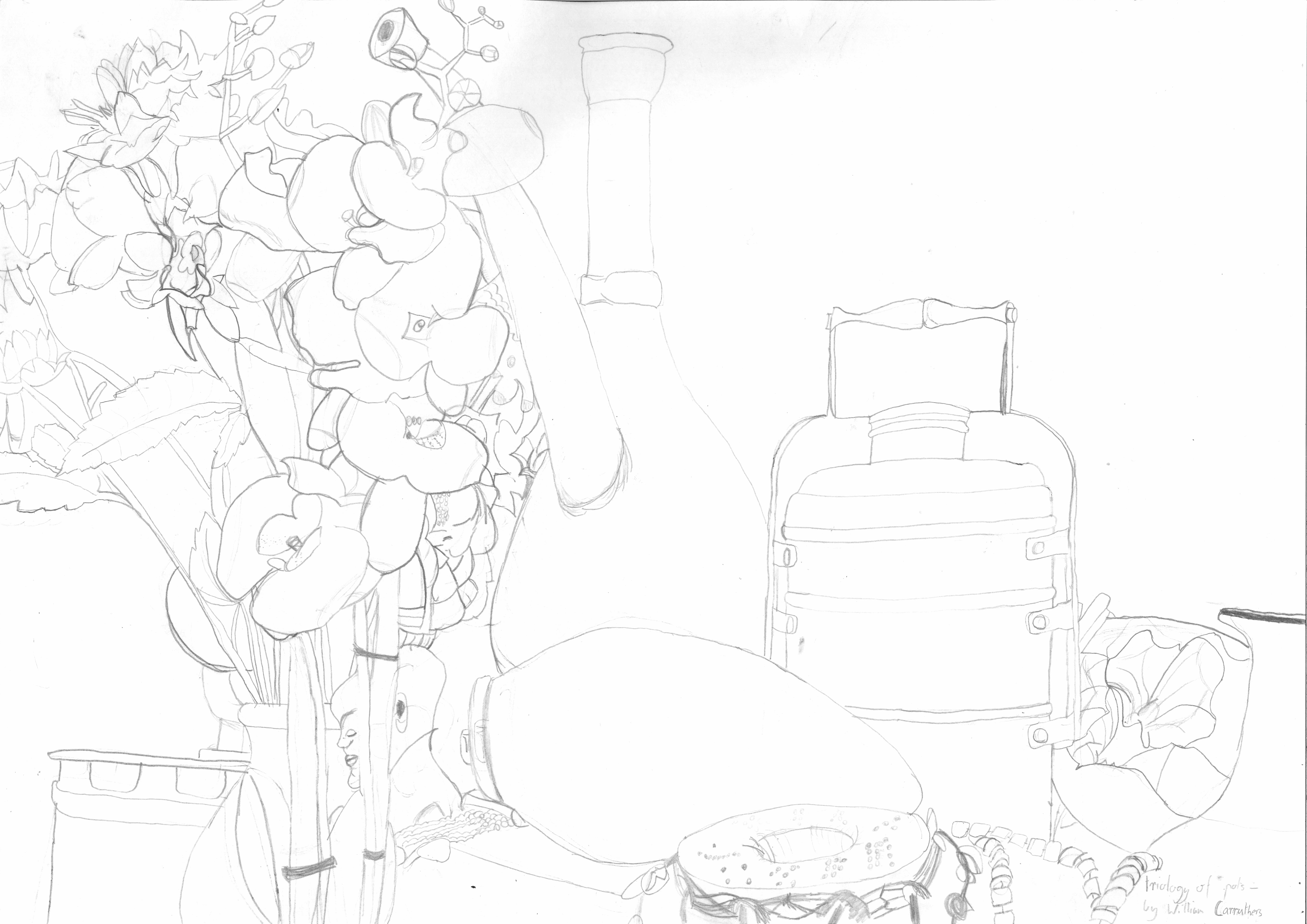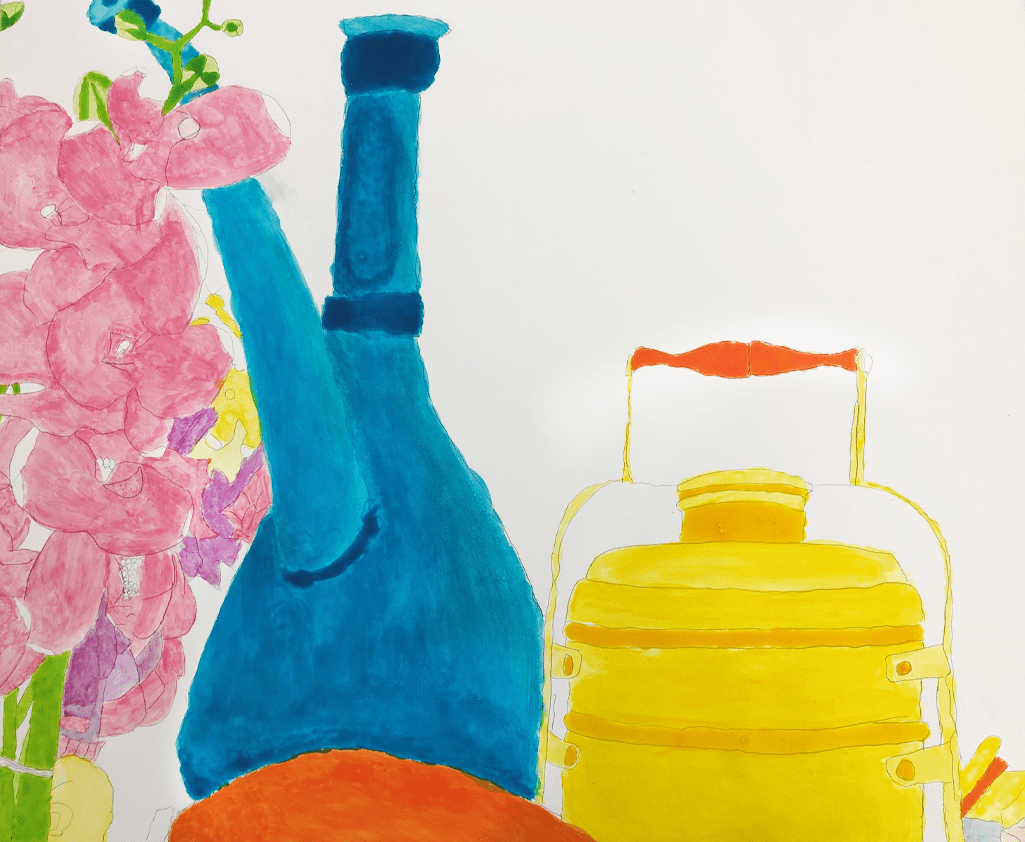What is it?

This is an example of an egg tempera painting and the renaissance period.
For our art project, we had to draw then paint a picture of still-life using egg tempera. Egg tempera is a type of paint that is commonly used by renaissance artists (further described later). This ‘draw then paint’ process was fun, but it had many different challenges that we needed to overcome. This post will further describe an in-detail description of these processes and challenges.
The Drawing Process

This is my still life drawing, I tried to make the pots the focus of the artwork
We spent many weeks practising ‘drawing with the left side of our brain’ to help us draw still life. We accomplished this by drawing silhouettes upside down. This was very challenging and involved us focusing on our drawing technique. This improved our still life drawing skills in preparation for our painting project.
We drew our still life using a contour type drawing technique (drawing which involves drawing what you see as lines(left)) of Indian style pottery, flowers, ornaments and figurines.
I found it extremely difficult to get everything to scale and try to fit it inside the drawing. However, I managed to find a way that involved using other objects inside the drawing to help get the scale to write on the object getting drawn. For example, if the pot I had drawn is twice as big as a vase in real life then I would use this to draw the vase smaller and, therefore, into scale with the pot. Eventually making the entire drawing relatively to scale around one object.

This is my prototype colour composition for my painting
I tried to make the pots the focus of the artwork and I believe that my artwork succeeds in this. I made this my goal because I believe the three pots next to each other looked quite nice and It adds attention to the pots and therefore more interest goes into my painting from the viewers. It sort of uses the rule of thirds placing certain areas of the pots on each joint of the rule of thirds. In my colour composition, This is furthermore exaggerated.
Egg Tempera
This is an example of the pigments we were using
After we completed our still life drawings we had to make and paint with egg tempera. This form of paint is created by using one egg yolk, 1.5 teaspoons of pigment, and 1 teaspoon of water. It uses the emulsion of egg yolk as a binder of liquid and dry pigments to create colour layers.
The steps of making egg tempera:
- Brake an egg
- Separate the egg yolk from the majority of the egg white
- Place the egg yolk on a folded paper towel.
- Role the egg yolk to a corner of the paper towel, this should remove any extra egg white
- Poke the skin of the egg yolk and drain out the yolk into a small bowl
- Add 1 teaspoon of water and 1.5 teaspoons (you can add as much as you like) of pigment
- Mix the egg tempera until all ingredients are thoroughly mixed
- The egg tempera is now ready, You can store it in a fridge until it becomes dark browny and smells ripe.
Egg tempera was used in the Renacaisence period by most artist, the most notable Leonardo de Vinci, Michelangelo and Raphael.
So far I have made 17 egg tempera paints each different colours. I have made so many because the fridge turned off after I made my first batch forcing me to create another. Making egg tempera is quite fun however it does take time and practice. The hardest part we found of making egg tempera was cracking the egg and separating the egg yolk from the egg white.
The Painting Process
We had to prepare our painting boards by sanding them smooth with fine-grit sandpaper. Then we had to print a copy of our line drawing onto clear paper. We then used a projector to draw the design onto our board. After that, we had to mix our pre-prepared egg tempera.

This is my egg tempera painting so far. As seen in the blue pot the egg tempera is a bit unreliable.
We then started to paint our artworks based on our colour composition. Mine is going quite well and I have learnt that you can use the brushes ability to absorb paints to help make the layers more even. I have also found that the egg tempera paint is much like oil paints however it dries much quicker.
Throughout this project, I have learnt and extended my knowledge of problem-solving as the paints and the painting didn’t always go to play. (The purple paints started turning grey and the yellow paint went off).
Thanks for reading
Thank you for reading, I hope you found this very egg-citing. But I really should stop cracking egg jokes!
have you tried making egg tempera or have any comments? Please leave in the comment section below.